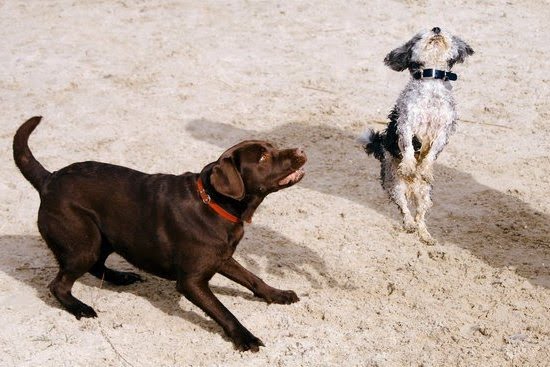Are you struggling with how to train your dog to behave off-leash? Off-leash training is not only a great way to give your furry friend freedom, but it also enhances the bond between you and your pet.
Establishing trust and good behavior in various environments is essential for the well-being of both you and your dog. In this article, we will delve into the importance of off-leash training, assess your dog’s readiness for this type of training, and provide tips for successful off-leash behaviors.
Assessing whether your dog is ready for off-leash training is crucial before embarking on this journey. It’s important to understand that not all dogs are immediately prepared for off-leash activities. Understanding your dog’s temperament, level of obedience, and their natural instincts will help determine their readiness for training beyond leash boundaries. Building a strong foundation through on-leash commands is vital before transitioning to off-leash activities.
Establishing a solid recall command is the key to success when it comes to off-leash training. A reliable recall ensures that your dog will return to you when called, regardless of distractions in the environment. With positive reinforcement training methods, consistency, and patience, you can effectively teach your dog to respond promptly to the recall command. Through this process, you can strengthen communication with your pet and build mutual trust that will be beneficial during off-leash activities.
Assessing Your Dog’s Readiness for Off-Leash Training
Before embarking on off-leash training, it’s important to assess whether your dog is ready for this type of training. Not all dogs are suited for off-leash activities, and it’s essential to ensure that your furry friend is capable of handling the freedom and responsibility that comes with being off-leash. Here are some factors to consider when assessing your dog’s readiness for off-leash training:
1. Obedience Level: Evaluate your dog’s current level of obedience and responsiveness to basic commands such as sit, stay, and come. A strong foundation in obedience training is crucial before transitioning to off-leash training.
2. Distraction Tolerance: Assess your dog’s ability to remain focused and attentive in the presence of distractions such as other animals, people, or environmental stimuli. Dogs with a high tolerance for distractions may be better candidates for off-leash training.
3. Exercise Needs: Consider your dog’s energy level and exercise needs. Dogs that require ample physical activity and mental stimulation may benefit from off-leash time to expend their energy in a controlled manner.
By carefully evaluating these factors, you can determine whether your dog is ready for off-leash training. It’s important to remember that not all dogs will be suitable candidates, and that’s perfectly okay. Each dog has unique traits and capabilities, so it’s crucial to tailor training methods according to individual needs.
Above all, patience, consistency, and positive reinforcement are key elements in successful off-leash training endeavors. By understanding your dog’s readiness for this type of training, you can set realistic expectations and work towards building a strong foundation for off-leash behavior.
Remember – assessing your dog’s readiness for off-leash training is the first step towards creating a positive experience for both you and your furry companion.
Establishing a Strong Recall Command
Understanding the Importance of Recall Command
The recall command is one of the most crucial aspects of off-leash training for dogs. It essentially means teaching your dog to come back to you when called, regardless of distractions or distance. This is essential for their safety and the safety of others, as well as allowing them the freedom to roam off-leash in appropriate areas. Without a reliable recall command, letting your dog off-leash can be risky and potentially dangerous.
Training Methods for a Strong Recall Command
When teaching your dog to behave off-leash, it’s important to use positive reinforcement training methods to establish a strong recall command. This means rewarding your dog with treats, praise, and other forms of encouragement when they respond promptly to your recall cue. Consistency is key, so practicing the recall command in various environments and gradually increasing distractions will help reinforce this behavior.
Practicing Patience and Persistence
It’s important to remember that training a dog to behave off-leash and have a reliable recall command takes time, patience, and persistence. Some dogs may grasp this concept quickly, while others may require more repetitive training sessions. Understanding your dog’s individual learning style and staying consistent with your training efforts will ultimately lead to success in establishing a strong recall command.
Tips for Positive Reinforcement Training Methods
When it comes to training a dog to behave off-leash, positive reinforcement is one of the most effective methods. Positive reinforcement involves rewarding your dog for exhibiting the desired behavior, which can encourage them to continue doing so. One of the key aspects of positive reinforcement training is consistency. It’s important to reward your dog every time they display good behavior off-leash, whether it’s coming when called or staying by your side.
Another tip for positive reinforcement training methods is to use high-value rewards. Different dogs have different preferences when it comes to treats and rewards, so it’s important to find out what motivates your dog the most. This could be pieces of cooked chicken, cheese, or even a favorite toy. By using high-value rewards, you can effectively capture and maintain your dog’s attention during off-leash training sessions.
In addition to using rewards, it’s also crucial to pair them with verbal praise and physical affection. Dogs thrive on their owner’s approval and love, so combining treats with verbal cues such as “good boy/girl” and gentle petting reinforces the positive association with off-leash behaviors.
| Positive Reinforcement Tip | Description |
|---|---|
| Consistency | Reward your dog every time they display good behavior off-leash. |
| High-Value Rewards | Find out what motivates your dog the most and use those treats or toys as rewards. |
| Verbal Praise and Physical Affection | Combine treats with verbal cues and gentle petting for positive association. |
Practicing Off-Leash Behaviors in Controlled Environments
When it comes to off-leash training for your dog, practicing in controlled environments is crucial for their safety and the success of the training. Here are some tips for practicing off-leash behaviors in controlled environments:
1. Start in a fenced-in area: Begin your off-leash training in a secure, fenced-in area such as a backyard or a dog park with a secure perimeter. This will provide a safe environment for your dog to practice being off-leash without the risk of them running off into potential danger.
2. Use a long line: If you’re not ready to completely let your dog off-leash, using a long line can be a great way to give them more freedom while still having control. A long line allows your dog to explore and move around more freely while still being under your supervision and command.
3. Practice recall commands: During off-leash training in controlled environments, continuous practice of recall commands is essential for reinforcing good behavior and ensuring that your dog listens to you even when they are not on a leash.
Remember, training your dog to behave off-leash takes time and patience, but with consistent practice and positive reinforcement, you can help them learn how to behave responsibly when they are not tethered to their leash or collar.
Addressing Challenges and Common Misconceptions of Off-Leash Training
Consistency Is Key
One of the biggest challenges in off-leash training is maintaining consistency. It’s important to remember that training your dog to behave off-leash is an ongoing process that requires patience and dedication. Consistency in your commands, expectations, and rewards is essential for your dog to understand what is expected of them when they are off-leash. Inconsistency can lead to confusion for your dog and hinder their progress in learning how to behave off-leash.
Distractions and Temptations
Another common challenge in off-leash training is managing distractions and temptations. Whether it’s other dogs, wildlife, or interesting scents, there will always be potential distractions when your dog is off-leash. It’s important to gradually expose your dog to these distractions and teach them how to focus on you despite the tempting distractions. This can be achieved through positive reinforcement techniques and consistent training in different environments.
Common Misconceptions
There are also common misconceptions about off-leash training that can hinder a dog owner’s success. One misconception is that some dog owners believe their dog will naturally know how to behave off-leash without any formal training. In reality, off-leash behavior must be taught and reinforced through consistent training methods.
Another misconception is that once a dog has been trained off-leash in one environment, they will automatically behave the same in all environments. It’s important for dog owners to understand that each new environment presents its own set of challenges and requires additional training and practice for the dog to generalize their behavior across various settings.
Building Trust and Bonding With Your Dog Through Off-Leash Training
Off-leash training is not only about teaching your dog to behave outside of the confines of a leash, but it is also an opportunity to strengthen the bond and trust between you and your furry friend. When you train your dog to behave off leash, you are demonstrating confidence in their ability to follow commands and make good choices, which can deepen the connection between you.
One way to build trust through off-leash training is by maintaining consistency in your interactions with your dog. Using consistent verbal cues and body language helps your dog understand what is expected of them, creating a sense of predictability and security. This consistency can help foster trust as your dog learns that they can rely on you for guidance and support during off-leash activities.
In addition to consistency, positive reinforcement plays a crucial role in building trust during off-leash training. When your dog responds correctly to commands while off leash, praise and rewards can reinforce their behavior and create a positive association with following instructions.
This positive reinforcement not only helps in shaping desired behaviors but also reinforces the bond between you and your dog, as they learn that listening to you brings about pleasant outcomes. By using positive reinforcement consistently during off-leash training, you can help build trust and strengthen the bond with your dog.
Safety Measures and Precautions for Off-Leash Activities
Off-leash activities can be an enjoyable experience for both you and your dog, but it is essential to prioritize safety. Before allowing your dog off-leash, ensure that he has a strong recall command in place.
This means that he should reliably return to you when called, even in distracting environments. If you’re unsure about how to train your dog to behave off leash and develop a reliable recall, consider enlisting the help of a professional trainer who specializes in off-leash training.
Another important safety measure is assessing the environment where you plan to let your dog roam off-leash. Look out for any potential hazards such as roads, bodies of water, or wildlife that could pose a danger to your dog. Additionally, make sure that the area is suitable for off-leash activities and allows dogs to run and play freely without causing trouble for others.
Even with thorough training and preparation, accidents can happen. Investing in a GPS tracker or ensuring your dog is microchipped can provide added security in case he wanders too far or gets lost during off-leash activities.
Remember that it’s crucial to abide by local leash laws and regulations when engaging in off-leash activities. Being respectful of others using the same space and their dogs’ comfort level with off-leash interactions is also essential for fostering positive experiences for everyone involved.
| Safety Measure | Description |
|---|---|
| Strong Recall Command | Teach your dog how to reliably return when called. |
| Assessing Environment | Ensure that the area is safe and suitable for off-leash activities. |
| GPS Tracker/Microchip | Invest in technology that can help locate your dog if he gets lost. |
By following these safety measures and precautions, you can help ensure that both you and your furry companion have an enjoyable and safe time during off-leash activities. Remember that proper preparation and ongoing training are key components of successful off-leash experiences with your dog.
Beyond Training
In conclusion, training a dog to behave off-leash requires dedication, patience, and consistency. Understanding the importance of off-leash training is crucial for both the safety of the dog and the enjoyment of outdoor activities. By assessing your dog’s readiness for off-leash training and establishing a strong recall command, you can set the foundation for success.
Positive reinforcement training methods play a significant role in teaching dogs to behave off-leash. Rewarding good behavior encourages dogs to repeat desired actions and reinforces their understanding of what is expected of them. Consistent practice in controlled environments allows dogs to gradually improve their off-leash behaviors, preparing them for various real-life situations.
It is important to address challenges and common misconceptions about off-leash training, as well as implementing safety measures and precautions for off-leash activities. Building trust and bonding with your dog through off-leash training not only strengthens your relationship but also enhances their responsiveness to commands. Overall, by following these tips and being committed to the process, you can successfully train your dog to behave off-leash in various environments.
Frequently Asked Questions
How Do You Train a Dog to Be Off the Leash?
Training a dog to be off the leash requires patience, consistency, and positive reinforcement. Start in a safe, enclosed area and gradually increase freedom as the dog shows reliability with commands like “come” and “stay.”
How Do I Transition My Dog Off the Leash?
Transitioning your dog off the leash should be done gradually and in a controlled environment. Start by using a long lead to give your dog some freedom while still maintaining control. Practice recall commands in low-distraction environments before progressing to busier areas.
How Do I Train My Dog to Come Back When Off the Lead?
Training your dog to come back when off the lead involves using high-value treats, positive reinforcement, and consistent practice. Start in a quiet area and gradually introduce distractions, rewarding your dog for coming back to you even when there are other interesting things around.

Welcome to the blog! I am a professional dog trainer and have been working with dogs for many years. In this blog, I will be discussing various topics related to dog training, including tips, tricks, and advice. I hope you find this information helpful and informative. Thanks for reading!





